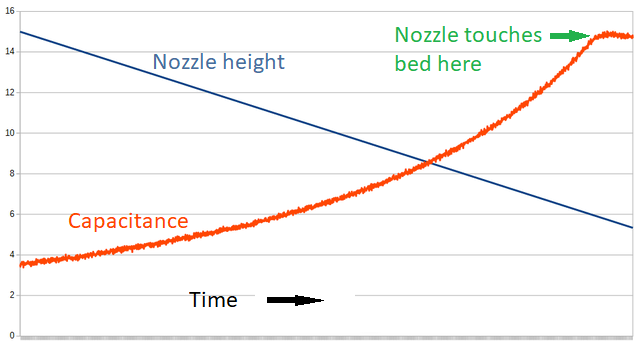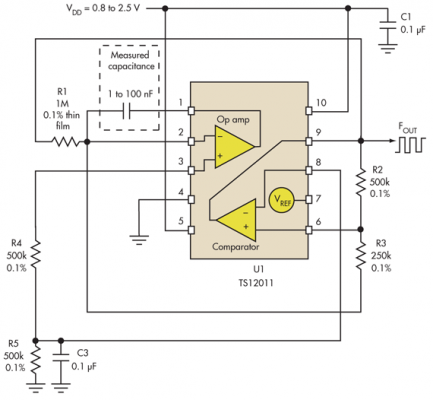Home
>
Developers
>
Topic
Analog output proximity sensor
Posted by leadinglights
|
Analog output proximity sensor January 24, 2018 05:02AM |
Registered: 12 years ago Posts: 1,450 |
Question: Are there any proximity sensors that give an analog output?
I do know that DC42s IR sensor has an analog output and that if you are willing to pay over £200 there are several inductive ones but nothing else jumps out from eBay, amazon or even Alibaba that fits the bill. Can an inductive probe be canabalized to get at a part of the circuitry that would do it?
The question is because I am playing with an idea that has nagged at me since doing a little research on bed leveling sensors. Sensors are mostly either nozzle contact e.g., Piezo, FSR, Strain Gauge etc., or they are proximity senors, inductive, capacitive, optical etc.. The one exception that I have found is the latest Ultimaker 3 which uses the nozzle itself as a capacitative proximity sensor: As the nozzle gets closer to the bed the capacitance increases until it touches the bed and can't increase any more - I have adopted and annotated a diagram from Daid on [community.ultimaker.com] which explains this.
My thought is that any sensor which is able to give an output at least roughly proportional to distance could become that basis of a really good leveling technology. The main requirements are a reasonable resolution, a fairly short latency (time between the sensor reaching a height and the microcontroller getting this data) and a halfway reasonable short term stability.
The sequence is this:
1. The nozzle is moved to say 5mm above the bed then moves slowly towards the bed while the analog output from the sensor is measured.
2. When the nozzle contacts the bed the capacitance stops going up and the nozzle retracts a known distance.
The important point here is that the distance is known from how far the stepper or serve needed to be driven so long term stability is not a major issue.
3. The last stage is that the sensor can now scan the whole of the print bed at any desired resolution and at high speed - without pogoing at each point.
Absolute linearity is also not a big problem as this can be mapped in much the same way as a thermistor table can be used to linearize its response.
Any thoughts? Is this a project that may be worth investigating?
Mike
I do know that DC42s IR sensor has an analog output and that if you are willing to pay over £200 there are several inductive ones but nothing else jumps out from eBay, amazon or even Alibaba that fits the bill. Can an inductive probe be canabalized to get at a part of the circuitry that would do it?
The question is because I am playing with an idea that has nagged at me since doing a little research on bed leveling sensors. Sensors are mostly either nozzle contact e.g., Piezo, FSR, Strain Gauge etc., or they are proximity senors, inductive, capacitive, optical etc.. The one exception that I have found is the latest Ultimaker 3 which uses the nozzle itself as a capacitative proximity sensor: As the nozzle gets closer to the bed the capacitance increases until it touches the bed and can't increase any more - I have adopted and annotated a diagram from Daid on [community.ultimaker.com] which explains this.
My thought is that any sensor which is able to give an output at least roughly proportional to distance could become that basis of a really good leveling technology. The main requirements are a reasonable resolution, a fairly short latency (time between the sensor reaching a height and the microcontroller getting this data) and a halfway reasonable short term stability.
The sequence is this:
1. The nozzle is moved to say 5mm above the bed then moves slowly towards the bed while the analog output from the sensor is measured.
2. When the nozzle contacts the bed the capacitance stops going up and the nozzle retracts a known distance.
The important point here is that the distance is known from how far the stepper or serve needed to be driven so long term stability is not a major issue.
3. The last stage is that the sensor can now scan the whole of the print bed at any desired resolution and at high speed - without pogoing at each point.
Absolute linearity is also not a big problem as this can be mapped in much the same way as a thermistor table can be used to linearize its response.
Any thoughts? Is this a project that may be worth investigating?
Mike
|
Re: Analog output proximity sensor January 24, 2018 06:03AM |
Registered: 10 years ago Posts: 14,672 |
A few years ago I built a capacitive sensor that gave an analog output, and I started building an inductive one that did too. But I abandoned them when I discovered differential IR.
I've never taken a commercial inductive sensor apart, so I don't know whether they use analog electronics or microcontrollers these days.
Large delta printer [miscsolutions.wordpress.com], E3D tool changer, Robotdigg SCARA printer, Crane Quad and Ormerod
Disclosure: I design Duet electronics and work on RepRapFirmware, [duet3d.com].
I've never taken a commercial inductive sensor apart, so I don't know whether they use analog electronics or microcontrollers these days.
Large delta printer [miscsolutions.wordpress.com], E3D tool changer, Robotdigg SCARA printer, Crane Quad and Ormerod
Disclosure: I design Duet electronics and work on RepRapFirmware, [duet3d.com].
|
Re: Analog output proximity sensor January 24, 2018 08:08AM |
Registered: 7 years ago Posts: 270 |
ESP32 and probably most other new SoC have capacitive touch peripherals that measure capacitance.
I also seen astable multivibrator examples that use capacitance to change oscillation frequency that can be sampled with uC:
Edited 1 time(s). Last edit at 01/24/2018 08:18AM by newbob.
I also seen astable multivibrator examples that use capacitance to change oscillation frequency that can be sampled with uC:
Edited 1 time(s). Last edit at 01/24/2018 08:18AM by newbob.
|
Re: Analog output proximity sensor January 24, 2018 09:08AM |
Registered: 12 years ago Posts: 1,450 |
That might even be the way to go as even Microchip PIC16s are available with CapSense. Inductive may also be good or possibly ultrasonic like AlignG [aligng.com] which has an analog output but won't tell anybody the price.
At the moment DC42s IR sensor looks a good place to begin but I won't be able to try anything out much before summer.
Mike
At the moment DC42s IR sensor looks a good place to begin but I won't be able to try anything out much before summer.
Mike
|
Re: Analog output proximity sensor January 24, 2018 11:04AM |
Registered: 7 years ago Posts: 270 |
|
Re: Analog output proximity sensor January 24, 2018 03:13PM |
Registered: 10 years ago Posts: 14,672 |
You don't need anything complicated to do capacitive sensing. My prototype capacitive height sensor used a <$1 attiny microcontroller and a few external resistors and capacitors. I still have the code if anyone wants it. However, capacitive sensors are sensitive to humidity and temperature as well as bed surface, so they are probably the least accurate type of height sensor to use.
Large delta printer [miscsolutions.wordpress.com], E3D tool changer, Robotdigg SCARA printer, Crane Quad and Ormerod
Disclosure: I design Duet electronics and work on RepRapFirmware, [duet3d.com].
Large delta printer [miscsolutions.wordpress.com], E3D tool changer, Robotdigg SCARA printer, Crane Quad and Ormerod
Disclosure: I design Duet electronics and work on RepRapFirmware, [duet3d.com].
|
Re: Analog output proximity sensor January 25, 2018 02:18AM |
Registered: 8 years ago Posts: 5,232 |
I've got two 18mm capacitve sensors, which also have sort_of_analog output. I didn't digg deeper into that subject. They send out a frequency that changes with distance. Also changes PWM duty cycle.
IDK if mesh probing in Pogo style is such a bad idea. Because it offers a visual way for me to see when it has triggered.
I only do it once after I changed anything in the printer hardware, then use G29 S1.
Ebay.de link
IDK if mesh probing in Pogo style is such a bad idea. Because it offers a visual way for me to see when it has triggered.
I only do it once after I changed anything in the printer hardware, then use G29 S1.
Ebay.de link
|
Re: Analog output proximity sensor January 25, 2018 10:19AM |
Registered: 12 years ago Posts: 1,450 |
@o_lampe
Can you tell us what the make and model of that capacitave sensor is?
There is nothing wrong with pogo mesh probing but if the datum height has been established by one dive to nozzle contact then it is no longer necessary and mesh scanning can take place at speed. As with any printer, if it is solid then it needs only a sanity check, one or three point, to see that nothing has gone wrong - like a bit of ABS under the removable bilid stage.
Mike.
Can you tell us what the make and model of that capacitave sensor is?
There is nothing wrong with pogo mesh probing but if the datum height has been established by one dive to nozzle contact then it is no longer necessary and mesh scanning can take place at speed. As with any printer, if it is solid then it needs only a sanity check, one or three point, to see that nothing has gone wrong - like a bit of ABS under the removable bilid stage.
Mike.
|
Re: Analog output proximity sensor January 26, 2018 03:05AM |
Registered: 8 years ago Posts: 5,232 |
Quote
@o_lampe
Can you tell us what the make and model of that capacitave sensor is?
I gave you the link to a german vendor, but his part number is the same as any other: LJC18A3-8-Z/BX. Maybe you can search for the phrase "dual mode", too?
The sticker is in chinese and there is the brand name? ZHNQI on it.
|
Re: Analog output proximity sensor January 26, 2018 04:31AM |
Admin Registered: 16 years ago Posts: 13,884 |
... some years ago I've built a 3D probe, where the sensor body was floating in ferrofluid and "fixed" by magnets.
There were 6 caps (pairs for X, Y and Z) as sensors around the body to detect the displacement of it in all directions. As the caps were placed inside the ferrofluid, they weren't sensitive to surrounding air or humidity
Viktor
--------
Aufruf zum Projekt "Müll-freie Meere" - [reprap.org] -- Deutsche Facebook-Gruppe - [www.facebook.com]
Call for the project "garbage-free seas" - [reprap.org]
There were 6 caps (pairs for X, Y and Z) as sensors around the body to detect the displacement of it in all directions. As the caps were placed inside the ferrofluid, they weren't sensitive to surrounding air or humidity

Viktor
--------
Aufruf zum Projekt "Müll-freie Meere" - [reprap.org] -- Deutsche Facebook-Gruppe - [www.facebook.com]
Call for the project "garbage-free seas" - [reprap.org]
Sorry, only registered users may post in this forum.

